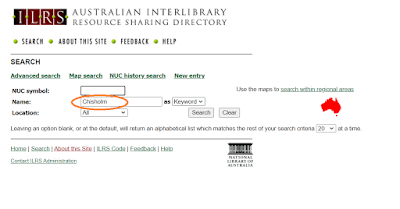The Inter Library Loans (ILL) Officer's Toolkit
Consists of:
- Policies
- Databases
- Networks
Policies - Internal
Your library’s Collection Development Policy – it should refer to the use of ILLs as a tool to obtain items which can’t be collected but may be requested by customers
Your library’s Loans Policy – this may refer to ILLs, particularly loan periods
Your library’s Inter Library Loan Policy – sometimes this is included in the Loans Policy
Policies – External
The Interlibrary Loan Resource Sharing Code (ILRS)
The Guide to Best Practice for Interlibrary Resource Sharing in Australia
Other Libraries’ ILL Practices and Policies
The ILRS Directory is a directory of Australian interlibrary loan and document delivery services and National Union Catalogue (NUC) symbols.
What are NUC symbols?
National Union Catalogue (NUC) symbols are unique identifiers for organisations which contribute information to the Australian National Bibliographic Database (ANBD) and/or to Trove. They are issued by the National Library of Australia. http://www.nla.gov.au/ilrs/about.html
Use this to find out about a library - its address, loan policy, services etc.
The Australian Interlibrary Resource Sharing (ILRS) Directory is the primary source for finding a contact for interlibrary loan and document delivery services within Australia and for discovering information about interlibrary loan charges and policies. It is also the directory of Australian National Union Catalogue (NUC) symbols. Australian libraries participating in the Australian interlending community are eligible for entry in the Directory, which also lists organisations such as art galleries, museums, historical societies and commercial services.
Here is an example of Chisholm Institute's information on the ILRS Directory
Australian Libraries Gateway
The Australian Libraries Gateway (ALG) is a free web-based directory service which has information about approximately 5,200 Australian libraries, their collections and services.
Started in March 1998, it aims to be a directory of current information about every library in Australia.
Think of it as a "one-stop-shop" for information about Australian libraries.
It is a tool for worldwide users, for both library professionals and the general public.
In 2009, when Trove was released, the ALG was expanded to include an additional library type of “Trove Contributor”. Trove contributors are not always libraries but are cultural institutions that have organised collections and metadata that can be included in Trove.
The Gateway has been developed on behalf of the Australian library and cultural institution community by the National Library of Australia and received initial funding as part of Australia's Cultural Network (ACN).
N.B. Not all of the links work on the site. Libraries update their websites regularly and the ALG has not always kept up.
Here are a few examples:
Find a library
Knowledge needed
Copyright Act – what restrictions are placed on the lending and requesting libraries
NUC (National Union Catalogue) symbols – a code assigned to a library by the National Library of Australia. The first letter of the NUC symbol signifies the state while the rest identifies the particular library
Categories of materials which are rarely/never loaned (with the exception of travelling exhibitions) e.g. manuscripts
Question: Do you know the NUC of your library?
What Not to Request on ILL as a Rule of Thumb
- Inexpensive items your library should buy
- Recent fiction from public libraries
- High-use and reserve collection items from academic libraries
- Equipment
- Reference books
- Rare materials
- Items from distant libraries if local libraries have copies
Best Libraries to which to send ILL requests
- Local libraries –this minimises the risk of loss
- Libraries who see their role as resource centres for the wider library community . Some even call themselves the libraries of “first resort”
- Libraries in the network to which your library belongs e.g. Translib – transport libraries
- Libraries which regularly borrow from your library
- Libraries which do not charge ILL fees
Activity: Find some information on the following selection of networks and consortiums:
QShare
CAVAL
One Card Network
Swift consortium (Libraries Victoria)
GratisNet
TAFE reciprocal borrowing scheme
ULANZ / CAUL / CEIRC
UNILINC / Ex Libris
IHEA / COPHE Library Network
Public Libraries Victoria Network (especially Library Link Victoria (LLV)
SALUS
WA Health Libraries Network
Difficult to Locate or Rarer Resources
Where can library staff go to locate unusual resources such as:
- complex or specialised information only accessible from other organisations
- foreign language materials
- items held in specialist external collections
- items not held with collections
- out of print materials?
Accessing other external sources such as:
- commercial document supply services
- electronic databases to which the organisation has access through networked sources or document delivery services such as LADD or LibraryLink
- information sources, such as: commercial vendors, companies, societies, galleries, museums, other information organisations both in Australia and overseas
Kick Start Websites
The following websites are examples of where/how you can find different sources of information.
ACRL/RBMS guidelines for interlibrary and exhibition loan of special collections materials. (2012). College & Research Libraries News, 73(7), 417-432.
Attar, K. (2014). A new book on old: a Directory of Rare Book and Special Collections. CILIP Update, 37-39.
Document Delivery
Libraries Australia Document Delivery – LADD
Read through the User Guides
















No comments:
Post a Comment